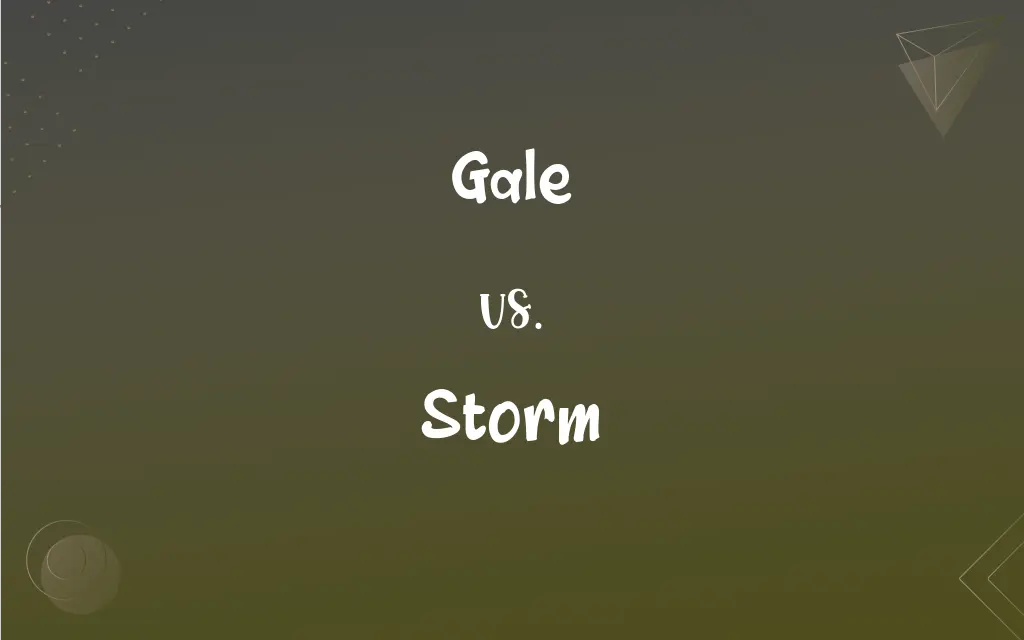Gale vs. Storm: What's the Difference?
Edited by Aimie Carlson || By Harlon Moss || Updated on November 2, 2023
A gale is a strong wind (34-47 knots), while a storm involves violent weather conditions including wind, rain, or snow.

Key Differences
A gale is specifically related to wind speeds that measure from 34 to 47 knots on the Beaufort scale. These winds are strong and capable of creating high waves at sea, but they do not necessarily include other weather phenomena such as rain or snow. Conversely, a storm refers to a wider range of weather conditions and is not limited to wind speed. It can include thunder, lightning, heavy precipitation, and high winds, sometimes even less than gale force.
When sailors speak of a gale, they refer to the strong winds that may hamper their progress and challenge their skills. These winds are part of a classification system that begins with light breezes and ends with hurricane-force winds. A storm, however, carries with it the connotation of disruptiveness and danger, extending beyond the maritime context to any severe weather scenario.
In maritime forecasts, a gale warning is issued to alert seafarers of expected winds that fall within the gale-force range. It is a specific term with clear criteria. A storm warning, however, is more severe and is issued when winds are expected to surpass 48 knots. This distinction is crucial for those at sea, as preparation for a storm involves different precautions than for a gale.
The impact of a gale is generally felt through its effects on the sea and wind-driven activities. It can cause trees to sway and can make outdoor activities difficult. A storm, on the other hand, can lead to a broad range of impacts, from downed power lines and flooding to the halting of outdoor and even indoor activities if severe enough.
In literature and common language, "gale" often has a romantic or adventurous connotation, evoking images of wind-swept landscapes or seascapes. "Storm," however, is used metaphorically to describe tumultuous situations or emotions, reflecting its broader and more intense nature as a weather event or as a metaphor for chaos.
ADVERTISEMENT
Comparison Chart
Definition
A strong wind, especially at sea, with speeds from 34 to 47 knots.
A violent weather condition with winds 48 knots or above, possibly including rain, snow, or thunder.
Beaufort Scale
Ranges from 8 to 9 on the Beaufort scale.
Can range from 9 upwards on the Beaufort scale.
Warning Signals
Specific "gale warning" issued for maritime activities.
"Storm warning" issued when severe weather conditions are expected.
Associated Weather
Predominantly wind-related, without the necessity of precipitation.
Often includes heavy precipitation, thunder, lightning, or other severe conditions.
Usage in Language
More specific, often related to sea conditions or wind-related events.
Broader usage, can refer to any severe or tumultuous situation.
ADVERTISEMENT
Gale and Storm Definitions
Gale
A forceful and continuous outpouring or stream of anything.
A gale of questions ensued after the surprising announcement.
Storm
A severe weather condition with high winds and often rain, thunder, lightning, or snow.
The storm uprooted trees and left the village without power.
Gale
A burst of sound or laughter, akin to a strong wind in intensity.
Her laughter was like a gale, infectious and unrestrained.
Storm
A sudden and severe outburst of something, typically emotion or activity.
A storm of applause followed the singer's performance.
Gale
A strong sea wind reaching from 34 to 47 knots.
The sailboat struggled to stay on course during the gale.
Storm
To attack or capture (a place) suddenly and forcefully.
The troops stormed the castle at dawn.
Gale
A metaphoric expression for a passionate emotional outburst.
He spoke with the force of a gale, his words resonating in the silent room.
Storm
A violent disturbance of the atmosphere with strong winds and usually rain, thunder, or snow.
The forecast predicts a storm coming our way this evening.
Gale
Nautical term for a very strong wind of shorter duration.
The old lighthouse withstood many a fierce gale over the years.
Storm
To move angrily or forcefully in a specified direction.
She stormed out of the room after the heated argument.
Gale
A wind with a speed of from 34 to 40 knots (39 to 46 miles per hour; 63 to 74 kilometers per hour), according to the Beaufort scale. Also called fresh gale.
Storm
An atmospheric disturbance manifested in strong winds accompanied by rain, snow, or other precipitation and often by thunder and lightning.
Gale
A storm at sea.
Storm
A wind with a speed from 48 to 55 knots (55 to 63 miles per hour; 89 to 102 kilometers per hour), according to the Beaufort scale. Also called whole gale.
FAQs
How do I prepare for a gale?
Secure loose objects, ensure safe shelter, and stay informed through weather updates.
What is the Beaufort scale level for a storm?
A storm starts at Beaufort scale level 9, with winds of 48 knots or more.
How does a storm affect daily life?
Storms can disrupt transportation, cause power outages, and lead to property damage.
Are gales dangerous?
Yes, gales can be dangerous, especially for marine and aeronautical activities.
Do storms always have lightning?
Not all storms have lightning; it depends on atmospheric conditions.
Are gales predictable?
Gales can be predicted with reasonable accuracy by meteorological services.
What is the speed range for a gale?
A gale has wind speeds from 34 to 47 knots.
Can a gale include rain?
While a gale refers to wind speeds, it can occur alongside rain.
What is the difference between a gale and a breeze?
A gale is much stronger than a breeze, which is a light, gentle wind.
Can gales cause damage?
Yes, gale-force winds can cause structural damage and uproot trees.
How long do gales last?
Gales can last from several hours to several days.
What's a gale warning?
A gale warning is an alert issued when gale-force winds are expected.
What is a synonym for gale?
"Strong wind" or "high wind" are synonyms for gale.
What safety measures should be taken during a storm?
Stay indoors, away from windows, and follow official safety advisories.
Is there a season for storms?
Some regions have storm seasons, like the Atlantic hurricane season.
Can you sail in a gale?
It is possible but risky and requires experience and proper equipment.
Is a hurricane a type of storm?
Yes, a hurricane is a type of storm characterized by intense winds and usually heavy rain.
Can storms cause flooding?
Yes, storms with heavy rainfall can lead to flooding.
Do all storms have names?
Not all storms are named; typically only tropical cyclones receive names.
Are gales measured on land?
Yes, gales can be measured on land using anemometers or other wind-speed instruments.
About Author
Written by
Harlon MossHarlon is a seasoned quality moderator and accomplished content writer for Difference Wiki. An alumnus of the prestigious University of California, he earned his degree in Computer Science. Leveraging his academic background, Harlon brings a meticulous and informed perspective to his work, ensuring content accuracy and excellence.
Edited by
Aimie CarlsonAimie Carlson, holding a master's degree in English literature, is a fervent English language enthusiast. She lends her writing talents to Difference Wiki, a prominent website that specializes in comparisons, offering readers insightful analyses that both captivate and inform.































































